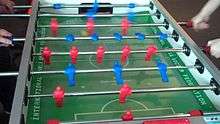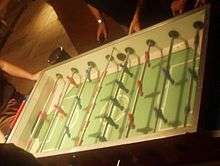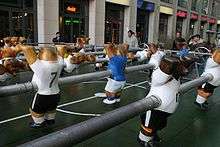Table football
 Table football (Bonzini style table) | |
| Highest governing body | International Table Soccer Federation |
|---|---|
| Nicknames | Table soccer, foosball, kicker |
| Invented | 1921 |
| Characteristics | |
| Contact | No |
| Team members | Single opponents, doubles, or teams of up to 4 |
| Mixed gender | Yes |
| Type | Table |
| Equipment | Football table |
| Presence | |
| Olympic | No |

Table football, commonly called fuzboll or foosball (as in the German Fußball "football") and sometimes table soccer, is a table-top game that is loosely based on association football.[1]
History
Although patents for similar games may exist from as far back as the 1890s, the game of table football as we know it today was first invented by Harold Searles Thornton in 1922 and patented in 1923 (UK patent no. 205,991 application dated 14 October 1922 and accepted 1 November 1923).[2]
The concept was conceived after Harold had been to a Tottenham Hotspur F.C. football match (he was an avid supporter). He wanted to provide a game that replicated football that could be played at home. The inspiration came from a box of matches: by laying the matches across the box he had formed the basis of his game.
His uncle (United States resident Louis P. Thornton, who once lived in Portland, Oregon) visited Harold and took the inspiration back to the USA where it was patented in 1927 (United States Patent Office No. 1,615,491). However, he didn't see a lot of success with the game and let his patent expire. It wasn't until decades later that the game took off in the USA. [3]
Meanwhile in Europe, the first leagues started springing up in the 1950s, and the European Table Soccer Union was formed in 1976. American soldier Lawrence Patterson re-introduced the game in the USA after playing in while stationed in Germany in the 1960s. He brought the first Bavarian-made table to the USA in 1962. Upon doing so, he trademarked the term "foosball" in both the USA and Canada, and gave his table the name "Foosball Match." [4] In 1970, Hayes and Furr created the first America-made foosball table, and shortly thereafter the game became a national phenomenon that lasted until video games became popular in the 1980s.
In 2002, the International Table Soccer Federation (ITSF) was established in France with the mission of promoting the sport of Table Soccer as an organizing sports body, regulating international competitions, and establishing the game with the International Olympic Committee (IOC) and General Association of International Sport Federation (GAISF). The U.S. joined ITSF in 2003.[5]
The sport
To begin the game, the ball is served through a hole at the side of the table, or simply placed by hand at the feet of a figure in the centre of the table. The initial serving side is decided with a coin toss. Players attempt to use figures mounted on rotating bars to kick the ball into the opposing goal. Expert players have been known to move balls at speeds up to 56 km/h (35 mph) in competition.[6]
Most rules consider "over 360-degree shots", or "spinning" (using the palm of the hand to swiftly spin the bar all around, instead of using wrist strokes to kick the ball with a bar-mounted figure) illegal.[7] However, there are many rules variations – in some variations, the keeper is allowed to spin, in others as long as a goal is scored from a controlled position, rotations of the rod after striking the ball are permitted. Generally, shots short of a full 360-degree rotation before (or after) striking the ball are legal. Since the establishment of the ITSF, the rules have become standardised in most international competitions. However, since January 2012, the annual World Championships and the World Cup will permit two full 360-degree rotations.[7]
The winner is determined when one team scores a predetermined number of goals, typically five, ten, or eleven in competition. When playing Bonzini competitions the target number of goals is seven. You must win by 2. Table football tables can vary in size, but a typical table is about 120 cm (4 ft) long and 61 cm (2 ft) wide. The table usually contains 8 rows of foos men, which are plastic, metal, wooden, or sometimes carbon-fibre figures mounted on horizontal metal bars. Each team of 1 or 2 human players controls 4 rows of foos men.
The following arrangement is common to ITSF competition tables,[8] though there are substantial variations, particularly in Spain and South America – where the Futbolín table model (or variants) is common and uses a different configuration. Looking from left to right on one side of the table, the configuration is usually as follows:

| Row 1 | Goalkeeper | 1 foosman (sometimes 2 or 3) |
| Row 2 | Defence | 2 foosmen (sometimes 3) |
| Row 3 | Opponent's attack | 3 foosmen (sometimes 2) |
| Row 4 | Midfield | 5 foosmen (sometimes 4 or 6) |
| Row 5 | Opponent's midfield | 5 foosmen (sometimes 4 or 6) |
| Row 6 | Attack | 3 foosmen (sometimes 2) |
| Row 7 | Opponent's defence | 2 foosmen (sometimes 3) |
| Row 8 | Opponent's goalkeeper | 1 foosman (sometimes 2 or 3) |
Table football can be played by two individuals (singles) – and also with four people (doubles), in which there are teams of two people on either side. In this scenario, one player usually controls the two defensive rows and the other team member uses the midfield and attack rows. In informal matches, three or four players per side are also common. A common slang used to describe a team which consists of three players is the term 'dreamteam'.
Competition



Table football is often played for fun in pubs, bars, workplaces, schools, and clubs with few rules. Table football is also played in official competitions organized by a number of national organizations, with highly evolved rules and regulations. Although organized competition can be traced back to the 1940s and 1950s in Europe, the professional tours and big money events began when the founding father of modern professional table soccer, Lee Peppard of Seattle, Washington, announced a "Quarter Million Dollar Tour" in 1976. Several organizations and promoters have continued holding large purse professional table soccer events worldwide. In 1976 Bobby Brown of Green Felt Billiards ended the season with 1305 points, the most ever recorded in a season.
The ITSF now regulates International events including the annual World Championships and the World Cup. The World Cup was originally intended to coincide with the FIFA World Cup, but since January 2009 it has run annually. In the ITSF World Cup and World Championships 2013, almost 500 players from 30 countries congregated in Nantes, France to compete. Team US produced a tremendous performance and won the World Cup.[9]

The ITSF World Tour has also recently expanded to include Asian countries. China, Taiwan and Malaysia played host to ITSF sanctioned tournaments in 2013, and more have been scheduled for 2014.[10]
Tables
A vast number of different table types exist. The table brands used at the ITSF World Championships are Bonzini, Roberto Sport, Garlando, Tornado, and Leonhart.[11]
Several companies have created "luxury versions" of table football tables. There was a 7-metre table created by artist Maurizio Cattelan for a piece called Stadium. It takes 11 players to a side. Differences in the table types have great influence on the playing styles. Most tables have one goalie whose movements are restricted to the goal area. On some of these tables the goalie becomes unable to get the ball once it is stuck out of reach in the corner; others have sloped corners to return the ball to play. Another major difference between table types is found in the balls, which can be made of wood (cork in the case of traditional French tables), various forms of plastic or rarely even marble and metal, varying the speed of shots a great deal, as well as the "grip" between the man and the ball and the ball and the playing surface.[12]
Robotic players
The table football robot Foosbot is claimed to have been beaten by a human several times, but has been tested against expert players.[13][14] Yet another table football robot is under development by two students at the Technical University of Denmark. The robot uses a camera mounted above an ordinary table.[15] Another bot has been devloped by two students at the EPFL (swiss school).[16]
In popular culture
The characters Monica Geller, Joey Tribbiani and Chandler Bing from the Friends TV show (1994–2004, US) often play table football. Foosball was a prominent part of the episode "Foosball and Nocturnal Vigilantism" on Community, a popular TV series.
Foosball has also been the subject of movies such as Longshot[17] (1981), and Underdogs (2013).
See also
References
- ↑ "BFA – Table Football". Britfoos.com. Retrieved 27 September 2010.
- ↑ "1923 Patent abstract". V3.espacenet.com. Retrieved 27 September 2010.
- ↑ http://www.smithsonianmag.com/history/the-murky-history-of-foosball-314668/?no-ist
- ↑ http://www.foosballrevolution.com/history/
- ↑ http://www.smithsonianmag.com/history/the-murky-history-of-foosball-314668/?no-ist
- ↑ Welcome to the official ciCMS: Foosball League Website
- 1 2 "ITSF" (PDF). Table-soccer.org. 15 January 2007. Retrieved 27 September 2010.
- ↑ "table-soccer.org". table-soccer.org. Retrieved 27 September 2010.
- ↑ "Patent abstract". www.table-soccer.org. Retrieved 25 January 2014.
- ↑ "Patent abstract". www.table-soccer.org. Retrieved 25 January 2014.
- ↑ "Official Table Partners - International Table Soccer Federation". Table-soccer.org. Retrieved 7 August 2015.
- ↑ "Foosball tables". Bestalyze. Retrieved 23 August 2016.
- ↑ "Top Bots excel at wide variety of tasks". University of Akron. 2012-04-25. Retrieved 2013-07-01.
- ↑ "TeamFoosbot's channel". YouTube. Retrieved 2013-07-01.
- ↑ Automated table football table project home page
- ↑ project home page
- ↑ Longshot (1981, US)
External links
| Wikimedia Commons has media related to Table football. |
- www.tablesoccerfriends.com - Project of a free table soccer matches score app
- www.foosballclubs.com - this is the new site for clubs in USA playing foosball
- www.table-soccer.org - official website for International Table Soccer Federation (ITSF)
- www.foosballreviews.com - Foosball table reviews, tips, and videos.
- www.foosballreviews.com - The history of foosball, a review of tables, bios on players, and tips and tricks.